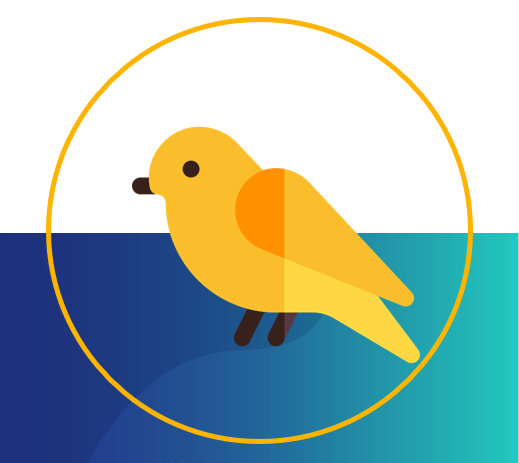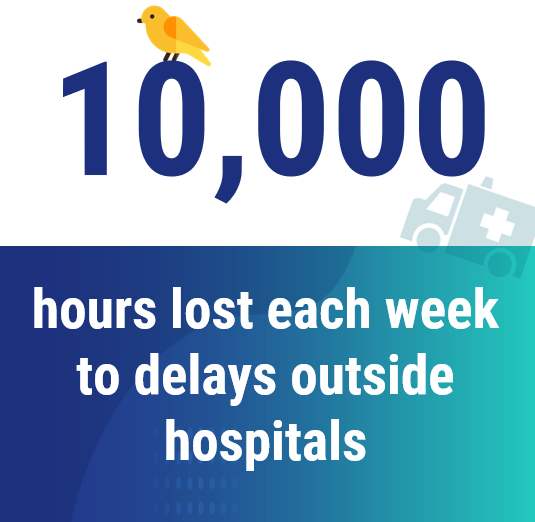
Everything about an ambulance is designed to catch your attention, but there is much more to these services than the blue lights you see in your rearview mirror. Our nation’s ambulance services run at a huge scale across vast regions, capturing millions of interactions per year and engaging with every other aspect of health and social care. The scale and breadth of their capability are massive. When we consider how ambulance services could provide additional support to our pressurised health and care system, we need to look beyond the blue lights and take an in-depth look at how they could be used.
The canary in the coal mine
1996 – The year that Google was launched at Stanford University, Dolly, the cloned sheep was born, and the legal requirement to keep canaries in British coal mines ended. That’s right, less than 30 years ago UK miners were still required by law under the Coal Mines Regulation Act to take small yellow birds into the depths of the earth to warn of impending disaster.

We tend to think of change moving at breakneck speed, but legacy practice remains everywhere and hangs around much longer than you’d think.
I was a member of the board of a UK ambulance service for two and a half years and we used the canary in the coal mine analogy frequently when speaking to fellow executives about the service. It works quite well.
They’re both yellow, they’re both loud and when they’re in trouble it tends to be an indicator of much bigger issues elsewhere.
Ambulance services, and urgent and emergency care (UEC) in general, tend to feel the pressures of the wider NHS first. If people can’t access services, they call 111 or 999 and suddenly the demand for those services spikes. If there is a potent new virus in circulation where the severity is unknown, those first afflicted are likely to need an ambulance response. As a result, the last few years have not been kind to UK Ambulance Services.
The gathering storm
In fact, to say things have been unkind is a sweeping understatement. The situation is catastrophic and has been for so long that people are beginning to get blind to the messaging. Some services are losing in excess of 10,000 hours a week to delays outside of hospital, which means that ambulances are spending thousands of hours parked, instead of responding to those in need.

The terminology doesn’t help. “Lost hours” conjures up an image of a wristwatch stuck down the back of the sofa. What the term really means is lost ambulance response time. If the average time taken for an ambulance to attend and then take a patient to the hospital was an hour (the reality is often lower) then 10,000 lost hours means 10,000 patients not seen in one trust, in one week alone.
UK ambulance services have lost over a million hours this year so far stuck outside hospital. The impact in some services is the same as simply giving away a third of their ambulance fleet at one of the busiest times in the history of the NHS.
This is having a devastating effect on some patients, who are left waiting for hours for the care they need. Some are held for over 12 hours in the back of ambulances outside the hospital, whilst some tragically die in the process. There are even instances of crews leaving an ambulance at the hospital to book off a 12-hour shift, only to return to the same ambulance in the same place with the same patient on board for the next shift.
The severity of the problem rightly led to the last Secretary of State for Health making A for Ambulance one of her priorities for fixing the NHS, but is that the right thing to focus on?
To stretch the canary analogy further, if you had a safety issue in the coal mine would you simply send down more canaries? Or, would the solution lie in fixing the mine?
UK ambulance services – Much more than blue lights
In the case of the canary, it is evident that just sending more is not the answer. However, in the case of UK ambulance services, it’s not that simple. The reason for that is twofold:
– They feel the pressure first because they’re connected to all other parts of the health and care system.
– They’re widely misunderstood.
To take the latter of those two points first, when people think of an Ambulance Trust, they immediately think of the bright yellow trucks with sirens and blue lights. What they rarely consider are the thousands of skilled staff working in call centres running 111 and 999. These elements are a service in their own right and, in tandem with the bright yellow trucks, they operate at a staggering scale.
There are ten Ambulance Trusts that cover the whole of England. Their coverage is massive for example, South West Ambulance Service covers over 20% of the land mass and London Ambulance Service covers over 15% of the population. Wales, Scotland and Northern Ireland all have a single service that covers the whole country. Each one takes millions of calls through their call centres every year, interacting with millions of patients, primary care, social care, acute care, mental health services and other service providers.
That’s tens of million of data points about patients across the UK. In a world where we are trying to join up care for our patients, should that be worthy of more attention?
Currently, ambulance services must act in a reactive way. Often there isn’t enough information about each patient to assess clinical risk in a way that offers any other option than to take them to the hospital, hence the importance of shared care record projects. It is then challenging for all UK ambulance services to find out what happened to that person after they were handed over. This makes it nearly impossible to assess whether they should have been taken by ambulance in the first place. Ultimately, too many people are taken to hospital that don’t necessarily need to be.
Stan’s story
Before he passed away, my grandfather (incidentally, a retired coal miner who’d used canaries) suffered from several conditions and one of those was congestive heart failure. It’s a terminal decline in the heart’s ability to do its job, but it can be managed for years with a cocktail of drugs. These dosages need to be continually tweaked to avoid fluid building up in the body, notably the lungs. When Stan’s dosage was off, he would wake up in the night finding it difficult to breathe and have a panic attack. At that point, he would press the panic alarm in his sheltered accommodation and immediately the next few weeks of his life would be predetermined.
The ambulance would be called as, without further knowledge, his carers had to assume that his symptoms were worthy of needing hospital attention. The paramedics would arrive, stay with him, assess him and then ultimately take him to the hospital. His age and set of conditions presented too much of a risk for him to be left without an alternative well-informed plan. The unavailability of data-led options would see him admitted to the emergency department and then the geriatric ward where he would receive care in isolation and then wait, holding a bed until his care needs could be assessed and he could be sent home.
The whole journey was predetermined due to the lack of an alternative, informed option. This led to a tough and tiring few weeks for my grandfather and a huge expenditure for the NHS.
Imagine if, when he pressed that panic button, the call handler that answered had access to a care plan. This would lead to a nurse or GP being dispatched, who were informed of his full care record. Imagine if the call handler could book follow on appointments and schedule a community nursing team visit the next day, all whilst liaising with the local pharmacy to adjust his medication requirements.
We could go one step further than that and predict the entire episode.
Driving change
Using the reach and scale of ambulances and telehealth isn’t a dream. Activity like this is already happening in pockets across the UK and abroad. Victoria in Australia runs a virtual emergency department where the ambulance service works with hospitals to allow people to attend A and E from their homes where appropriate. It was trialled last winter and was so successful that investment was made to double it in size this year. Closer to home Airedale NHS Foundation Trust runs a Digital Community Hub, where people with certain conditions like chronic obstructive pulmonary disease (COPD) ring an alternative service to 111 and 999 and are directly managed in a way that cares for them at home.
Imagine if we could all access those services nationally from the same point. The NHS App, 111 and 999 aren’t staffed or configured for that model yet, but in a world where we’re all used to a single point of access for so many services, as with services such as shopping and television, should we be considering the same for healthcare?
When we focus on ambulance services, should we stop seeing them as a helpless Canary and start seeing them as the foundational service integrator of the modern NHS we all need?
How could we do more?
Integrated care boards (ICBs) were brought in as part of integrated care systems (ICSs) to join up health and care, but we need to recognise that 10 ambulance services in England cover the same population and land mass. They liaise with multiple ICBs, multiple shared care records, GP providers, care homes and more. When we consider the transformation of urgent and emergency care, what better place to start?
We need to recognise the power of 111 and 999 call handling centres and link them more holistically with online service provision, community and pharmacy, with new pathways so that people can be referred to an alternative when ED isn’t the best option.
Stan passed away at the very beginning of the pandemic when there was less awareness of the impact that handover delays can have. In the new world, he would risk sitting in the ambulance and ED for a very long time when he could have avoided it altogether.
We need to support ambulance services and the wider UEC services to manage excessive demand and limited capacity under the current model. We also must explore what their incredible infrastructure could be capable of when enhanced with better online provision, greater links to other providers for new pathways and improved availability of data.
If you had a service that covered thousands of square miles and millions of patients with links to every other sector in health and care. How would you use it?
We need to realise what is possible before a service user picks up the phone and before an ambulance is dispatched. Our ambulance services are much more than the proverbial canary in the coal mine, they have the potential to completely shift the way in which better health and care is provided to the public. This is something that I plan to support in the coming months and years with my colleagues at Channel 3, as we enable digital transformation of health and care to build better lives through better care and better digital.
If you have a question for Andy, please use the contact form below. You can also follow him on LinkedIn.
About the author

Andy Haywood
Andy joined Channel 3 from the Welsh Ambulance Services NHS Trust (WAST), where he was CIO and a member of the board. Before WAST, hey worked in large acute trusts and NHS Digital, delivering complex programmes, cyber-security and policy roles. Prior to his NHS career, he was an officer in the Royal Navy for 12 years.

